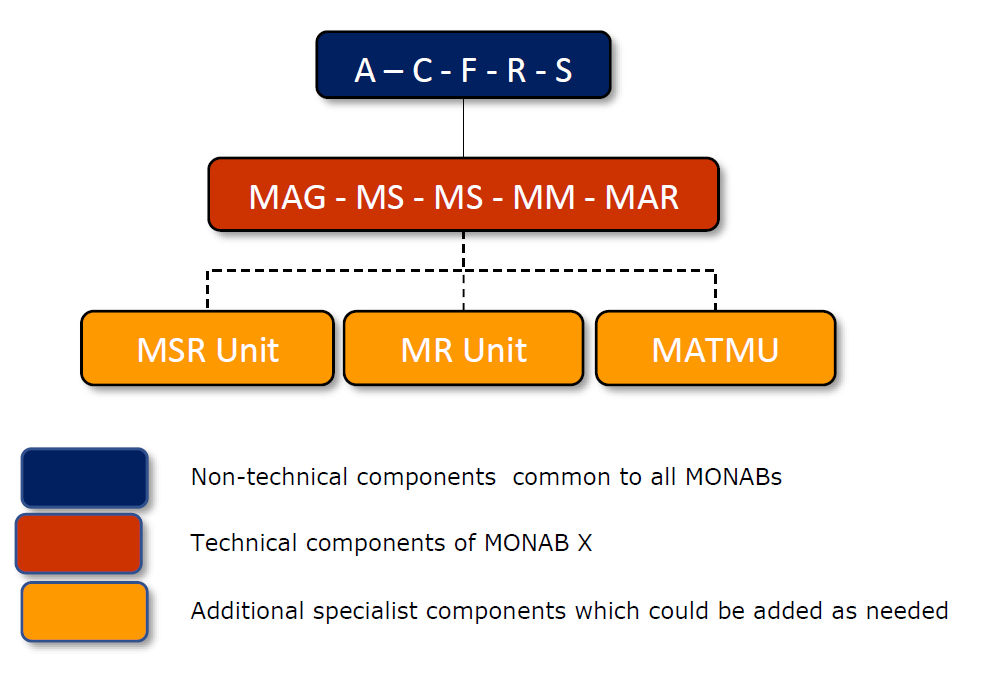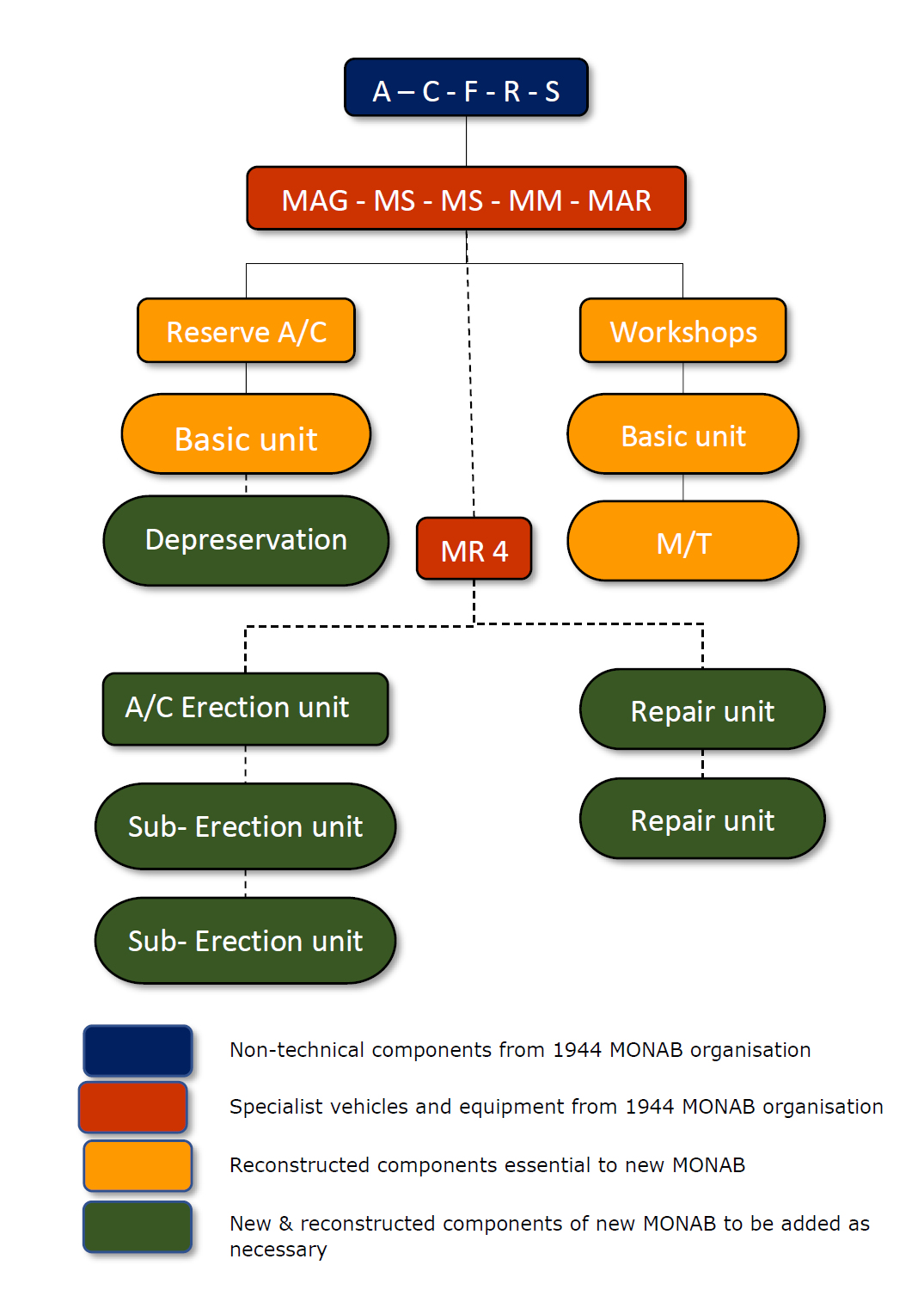Mobile Naval Air Base No. X
Assembly and commissioning
Personnel and equipment for Mobile Naval Air Base X began assembling at RNAS Middle Wallop on July 23rd as the third Fighter Support MONAB. TThe surrender of Japan on August 15th caused the Admiralty to take stock of MONAB operations and all MNAO operations were put on hold.
MONAB X was allocated the following maintenance components:
Mobile Maintenance unit (MM) No. 9 supporting Corsair Mk. II & IV, Seafire L.III & XV
Maintenance Servicing unit (MS) No. 17 supporting Hellcat Mk. II?
Maintenance Servicing unit (MS) No. 18 supporting Firefly Mk. I?
Mobile Repair unit (MR) No.3 supporting all front-line fighter types
Maintenance, Storage & Reserve (MSR) No. 11 supporting - believed to be Corsair Mk. II & IV, Firefly Mk. I, Hellcat Mk. II, Seafire Mk. L.III & XV
As a result of the Admiralty review it decided to approve the departure of MONAB IX and Maintenance, Storage & Reserve (MSR) No. 10, delayed by one week, and to continue the assembly of MONAB X, and MSR No. 11. Although the future of these two units was uncertain the Admiralty decided to proceed with commissioning MONAB X. A third unit, Mobile Repair 3 (MR 3) was also to have formed during August and was due for despatch overseas with MONAB X, and MSR No. 11 in late September, but this was cancelled and would be raised locally in Australia in November when the review of MONAB operations overseas would be implemented.
MONAB X Commissioned as an independent command bearing the ship's name HMS NABHURST on September 1st 1945, Commander T. S. Jackson in command. However, the unit was not destined to be despatched overseas, a role for MONAB X was found in the UK but not as a commissioned autonomous unit; HMS NABHURST paid off as an independent command at RNAS Middle Wallop on October12th 1945, its accounts reverting to being carried on the books of HMS FLYCATCHER.
Redesignated as a Trials & Development MONAB
The MONAB was to be retained in its original form for use by the Mobile Naval Airfields Organisation as a trials & development MONAB. All equipment together with the recently formed MR 4 were retained on a Care & Maintenance basis for future use. MR 4 had been assembled in September specifically for this purpose. A single Mobile Air Torpedo Maintenance Unit, MATMU No. 1 was also to be retained. MSR 11 was not to be retained and was disbanded.
The three trials & development elements of the peace-time MNAO remained at RNAS middle Wallop until HMS FLYCATCHER was paid off on April 10th 1946 and the station transferred back to RAF control. The MNAO was temporarily accommodated at three separate sites, RNAS Fearn, RNAS. Inskip and RNAE Risley whilst awaiting a move to its new hone Royal Air Force Station Lossiemouth, the station was due to commission as an RN Air Station in early July 1946. The MNAO and MONAB X were installed at Lossiemouth during May and June while the station was still under RAF control.
RNAS Lossiemouth commissioned as HMS FULMAR on July 12th 1946, the equipment of MONAB X and MATMU No. 1 all completed the move during this month. MR 4 was installed, on a semi-permanent basis, at RNAS Milltown the satellite airfield to Lossiemouth. All mobile radio equipment was retained at RNAE Risley for storage and maintenance. MONAB X's stock of Beste Burkle tents was reduced from 100 to 25 soon after its arrival, 75 being shipped out to RNAS Takali in Malta to form part of a reserve MONAB being assembled there.

The structure of MONAB X as assembled in September 1945
Over the next four years the components and structure of MONAB X were modified and redesigned, and new mobile equipment was tested for its suitability for field use. At some stage the organisations name was changed to reflect its new post-war role, becoming the MONAB Development Unit (MDU), the use of roman numerals for unit numbers was also dropped the trials unit becoming MONAB 10. By 1950 the unit was held in storage at RNAS Lossiemouth pending a decision about its future usage.
MONAB 10 reactivated and installed at a Naval Air Station
MONAB X's future was reviewed at a meeting held on September 13th 1950; this resulted in the proposed reconstruction and reactivation of the unit and its installation at a reserve airfield. Proposed sites for housing MONAB 10 included; Burscough, Crail, Evanton, Fearn, Henstridge, and Worthy Down, all RN Air Stations.
This was not the first time the suggestion to install the unit at a reserve station had been proposed. With the closure of the naval airfields in the Shetland and Orkney Islands after the war RNAS Dounreay was proposed as a temporary base for squadrons disembarking from ships visiting the anchorage at Scapa Flow. In order to provide facilities at the station, without commissioning it and providing a permanent complement, it would be manned by a Mobile Naval Air Base and a Fleet Requirements Unit would be made available. There is however no evidence to suggest that MONAB 10 was ever installed at RNAS Dounreay.
In March 1951, CDR (P) L.J.S. EDE DSO, DSC (former Commanding Officer of the MNAO) was appointed as Commanding Officer of MONAB 10 for the duration of the units forming up period. Confidential Admiralty Fleet Order (CAFO) 139/51 called MONAB 10 out of retirement, effective from September 7th 1951; the unit was to be installed at RNAS Henstridge, Dorset. All personnel for MONAB 10 were carried on the accounts of HMS HERON.
The MONAB that was to be installed at Henstridge differed slightly from those which operated during WW2, while many components still utilized the original specialist vehicles designed in 1944, other components were reconstructed or replaced completely by new ones.
| The
composition of MONAB 10 |
| Non-technical components: |
| Unchanged - A (Command & Executive), C (Medical), F (Flying Control), R (Radio & Radar), S (Stores) |
| Technical components: |
| [Retained original components] MAR (Maintenance Air Gunnery), MS (Maintenance Servicing (2 units)), MM (Mobile Maintenance (1 unit)), MAR (Maintenance Air Radio), and MR (Mobile Repair (1 unit)) |
| [Reconstructed elements] basic Reserve Aircraft Storage, basic Workshops, and Motor Transport Workshops. |
| Additional components to be added as necessary: |
| A Depreservation Unit to augment Reserve Aircraft Storage, an Aircraft Erection Unit (plus two sub erection units), and two supplementary Aircraft Repair Units to augment Mobile Repair. |

The revised structure of the trials and development MONAB
Operations at RNAS Henstridge
RNAS Henstridge, formerly HMS DIPPER had reopened in 1949 for use as a satellite to RNAS Yeovilton and was visited daily by aircraft from No.767 squadron which began using the Dummy Deck for the training of Deck Landing Control Officers (DLCOs). The squadron moved into the station completely at the start of 1952, taking up residence on January 4th while RNAS Yeovilton was closed to all flying for major runway reconstruction and extension works. The squadron’s Firefly FR.4s and Sea fury FB.IIs where the last flying unit to operate from the station, moving to RNAS Stretton on September 20th 1952. The station was now clear for the installation of MONAB 10.
The first components of MONAB 10 arrived at RNAS Yeovilton in the late spring of 1952, and the unit was installed at RNAS Henstridge by the autumn of that year. Mobile Repair 4 did not accompany MONAB 10 to Henstridge but remained at RNAS Milltown. The exact nature of MONAB 10's activities at Henstridge are not clear, but most likely it was a form of 'preservation by operation'. It should also be remembered that MONAB 10 was the only unit of its kind in existence, the War Reserve MONAB units overseas had been disbanded by this time. It may have been intended to evaluate the new MONAB for use in other conflicts.If the unit performed any meaningful activities on the airfield is unclear but it appears to been returned to storage once it had been assembled and installed. On January 23rd 1953 RNAS Henstridge was reduced to Care & Maintenance status at three months’ notice to re-open for use by MONAB 10. Areas of the airfield were allowed to return to agricultural use, buildings and hangars were retained for MONAB use. Equipment installed at RNAS Henstridge was maintained on a daily basis, the majority of the MONAB equipment and vehicles were stored in hangers at RNAS Yeovilton for much of the time, being rolled out for maintenance and then returned to storage.
Commander (P) E.G. Savage D.S.O., D.S.C. was appointed as Officer -in-Charge of MONAB 10 on August 8th 1953. He was relieved by Commander (P) M.J.A. O’Sullivan on May 5th 1954. The only other officer known to have been appointed to MONAB 10 is Lt. Cdr (E) S.F. Aldrch A.E.O. MONAB 10 as the unit’s A.ir Engineering Officer in March 1952.
MONAB 10 was disbanded on July 2nd 1955; the equipment was still at Henstridge and Yeovilton until at least the end of 1955, maintained by a small retard party of Lt.(E) (A.E) N.L. Jay and 12 men who were bussed out from Yeovilton daily. A number of former MONAB vehicles were moved to RNAS Lee-on-Solent and are known to have been in the 'van pool' - part of the Equipment & Trials section in late 1958.
HMS 'NABHURST'

Function
Fighter support MONAB providing support for disembarked front line Squadrons
Aviation support Components
Mobile Maintenance (MM) 9
Maintenance Servicing (MS) 17 & 18
Maintenance, Storage & Resave (MSR) 11
Aircraft type supported
Corsair Mk. II & IV
Firefly Mk. FR.
Hellcat Mk. I & II
Seafire Mk. III, L.III & XV
Commanding Officers
Commander T. S. Jackson 01 September 1945 to 12
October 1945
Unit decommissioned
Related items
R.N.A.S. Henstridge History of the airfield and other information - part of the Fleet Air Arm Bases web site
Reminiscences
Memories of those who served with MONAB X or 10
Radio Electrical Mechanic (Air) J. Hemming (MONAB 10)
Gallery
No images available for this unit
Comments (0)